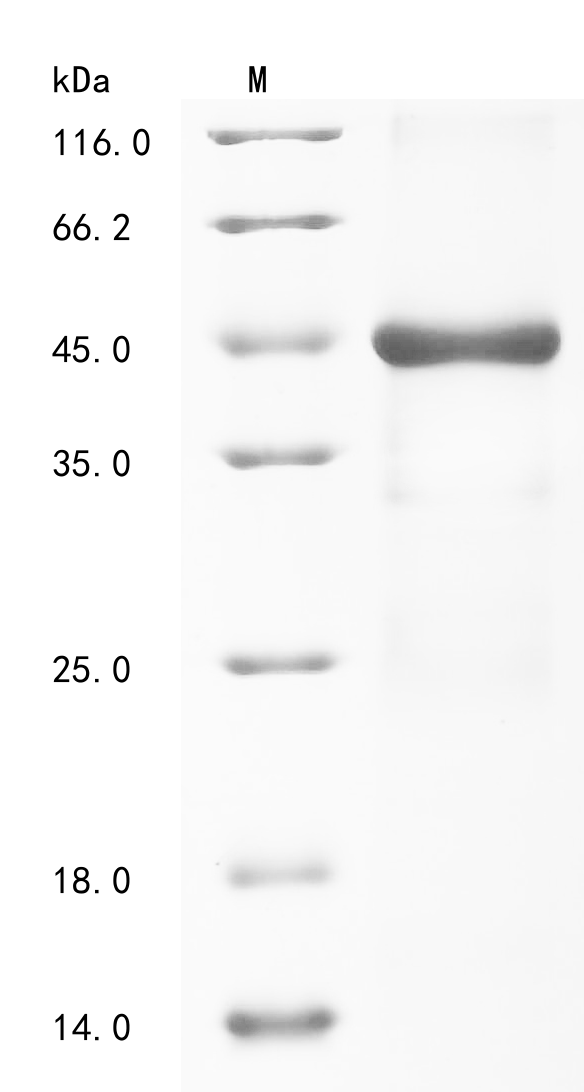Producing recombinant human Group 10 secretory phospholipase A2 (PLA2G10) in E. coli starts with co-cloning the target gene into an expression vector with an N-terminal 10xHis-GST-tag and C-terminal Myc-tag gene, which is introduced into E. coli cells. The target gene corresponds to the 43-165aa of human PLA2G10. These cells are cultured and induced for protein expression. The cells are lysed to release the protein, which is purified using affinity chromatography. Protein purity is checked by SDS-PAGE, reaching up to 85%.
Human PLA2G10 is a secretory phospholipase that hydrolyzes phospholipids, exhibiting a preference for polyunsaturated fatty acids (PUFAs) such as eicosapentaenoic acid (EPA), docosapentaenoic acid (DPA), and arachidonic acid (AA) [1]. This enzyme is expressed in male reproductive organs and/or sperm, indicating its involvement in reproductive processes [2]. PLA2G10 is associated with cancer progression by impairing T-cell infiltration, thereby dampening immunity in cold tumors [3].
Furthermore, human PLA2G10 is involved in immune responses, inflammation, and allergic conditions. PLA2G10 is linked to the production of pro-inflammatory cytokines such as TNF-α and IL-6 from human lung macrophages [4]. In asthma, PLA2G10 expression is notably higher in epithelial cells compared to other airway cells, suggesting a potential role in asthma pathogenesis [5]. The absence of PLA2G10 is related to attenuation of airway phenotypes and inflammatory markers in asthma models [6].
References:
[1] S. Tokuoka, Y. Kita, M. Sato, T. Shimizu, Y. Yatomi, & Y. Oda, Development of tandem mass tag labeling method for lipid molecules containing carboxy and phosphate groups, and their stability in human serum, Metabolites, vol. 11, no. 1, p. 19, 2020. https://doi.org/10.3390/metabo11010019
[2] T. Yamane, T. Shimizu, K. Takahashi-Niki, Y. Takekoshi, S. Iguchi‐Ariga, & H. Ariga, Deficiency of spermatogenesis and reduced expression of spermatogenesis-related genes in prefoldin 5-mutant mice, Biochemistry and Biophysics Reports, vol. 1, p. 52-61, 2015. https://doi.org/10.1016/j.bbrep.2015.03.005
[3] T. Zhang, Up-regulated pla2g10 in cancer impairs t cell infiltration to dampen immunity, Science Immunology, vol. 9, no. 94, 2024. https://doi.org/10.1126/sciimmunol.adh2334
[4] A. Igarashi, Y. Shibata, K. Yamauchi, D. Osaka, N. Takabatake, S. Abeet al., Gly80ser polymorphism of phospholipase a2-iid is associated with cytokine inducibility in a549 cells, Respiration, vol. 78, no. 3, p. 312-321, 2009. https://doi.org/10.1159/000213243
[5] T. Hallstrand, Y. Lü, W. Altemeier, C. Appel, B. Johnson, C. Frevertet al., Regulation and function of epithelial secreted phospholipase a2 group x in asthma, American Journal of Respiratory and Critical Care Medicine, vol. 188, no. 1, p. 42-50, 2013. https://doi.org/10.1164/rccm.201301-0084oc
[6] R. Lamb, Deadly h7n9 influenza virus: a pandemic in the making or a warning lesson?, American Journal of Respiratory and Critical Care Medicine, vol. 188, no. 1, p. 1-2, 2013. https://doi.org/10.1164/rccm.201305-0914ed






